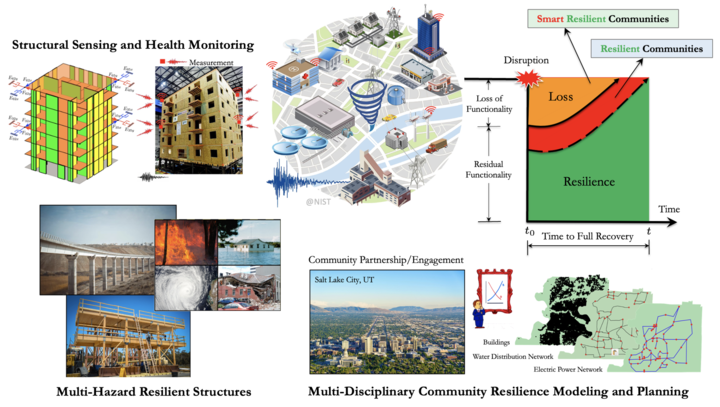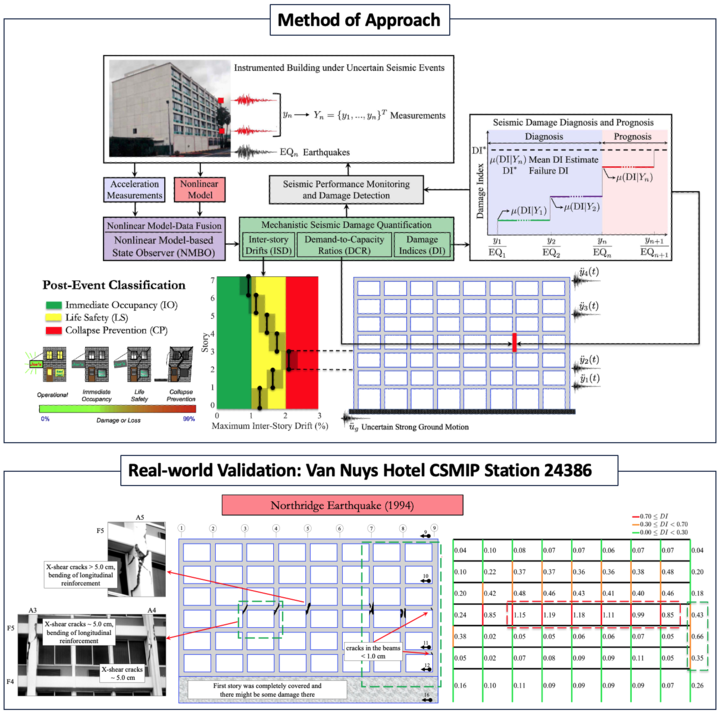Modern societies increasingly rely on the built environment to provide essential services that promote economic growth, social inclusion, governance, and quality of life. Severe natural hazards can manifest themselves in various direct and indirect losses to the built environment and disrupt the essential services, which results in a significant burden for individuals and communities seeking to recover from these hazards.
Our lab’s research aims to develop smart resilient structural, infrastructure and urban systems that minimize the impacts of damaging hazards and facilitate better informed post-hazard planning and recovery in disaster-prone areas.
Our lab is interested in the development of novel modeling and data fusion approaches that can combine information from multiple sources for quantitative structural monitoring and resilience assessment of civil infrastructure systems and, subsequently, for informed decision-making. We contribute to technological advancement toward the design and construction of resilient structural systems that could maintain or promptly recover functionality.

Research Project Highlights
Multi-Disciplinary Decision Support Methodology for Developing Mitigation Policies

Funded by National Institute of Standards and Technology (NIST)
This research aims to develop a multi-disciplinary decision support methodology to assist communities in developing mitigation policies. Our research team, consisting of engineers, urban planners, and social and economic scientists at the NIST Center for Risk-based Resilience Planning, is currently partnering with Salt Lake County in Utah to implement this approach for community resilience planning.
The multi-disciplinary decision support methodology begins with decision-makers setting community resilience goals for engineering metrics (such as building and infrastructure damage, functionality, and recovery), population dislocation, and economic metrics. A community resilience model is then developed using IN-CORE, incorporating engineering, social, and economic models. This model quantifies the impact of earthquake scenarios using multidisciplinary metrics.
The quantified metrics are then used to conduct a diagnostic analysis, identifying the building archetypes with the most severe damage and prioritizing their seismic design upgrades. This process continues with higher-priority archetypes until the predefined community resilience goals are achieved. The ultimate objective of the decision support methodology is to determine the new design requirements for all building archetypes in the community. Additionally, it calculates the total cost of retrofitting existing buildings in the community to meet these new design requirements.
Research Team:
Milad Roohi, Assistant Professor, Durham School of Architectural Engineering and Construction, University of Nebraska-Lincoln
John W. van de Lindt, Harold H. Short Endowed Chair Professor, Department of Civil and Environmental Engineering, Colorado State University
Martin Shields, Professor, Department of Economics, Colorado State University, Fort Collins, CO 80521 USA
Sara Hamideh, Associate Professor, School of Marine and Atmospheric Sciences, Stony Brook University
Harvey Cutler, Professor, Department of Economics, Colorado State University
Saeid Ghasemi, Ph.D. Student, University of Nebraska-Lincoln
Omar Sediek, Postdoctoral Fellow, Department of Civil and Environmental Engineering, Colorado State University
Hwayoung Jeon, Postdoctoral Fellow, Department of Economics, Colorado State University
Performance-based post-earthquake decision-making for instrumented buildings

Funded by National Science Foundation (NSF)
Funded by NSF, this project developed a decision-making framework for post-earthquake assessment of instrumented buildings in a manner consistent with performance-based design criteria. This framework is achieved by simultaneously combining and advancing existing knowledge from seismic structural health monitoring and performance-based earthquake engineering paradigms. The framework consists of (1) measurement, (2) uncertainty modeling, (3) dynamic response reconstruction, (4) damage estimation, and (5) performance-based assessment and decision making. Since the proposed framework is probabilistic, the outcome can be used to obtain the probability of losses based on the defined decision variables and be integrated into a risk-based decision-making process by city officials, building owners, and emergency managers. The framework is illustrated using data from the Van Nuys hotel testbed, a seven-story reinforced concrete building instrumented by the California Strong Motion Instrumentation Program (CSMIP Station 24386).
Research Team:
Milad Roohi, Assistant Professor, Durham School of Architectural Engineering and Construction, University of Nebraska-Lincoln
Eric M. Hernandez, Associate Professor, Department of Civil and Environmental Engineering, University of Vermont
David Rosowsky, Vice President for Research, Kansas State University
Cooperative Research to Enable Mass Timber Multi-Family Housing Technologies

Funded by United States Department of Housing and Urban Development (US-HUD)
This project aims to enable construction of low-cost resilient timber buildings by developing a novel balloon-style cross-laminated timber (CLT) structural system. In this project, I developed index building archetypes and performed computational OpenSees modeling and seismic collapse assessment based on the FEMA P695 in direct coordination and feedback from an Expert Panel comprised of stakeholders heavily involved in the mass timber wood industry and construction. The outcome of this project will serve directly as the design code proposal to the Provisions Update Committee of the Building Seismic Safety Council, and the ASCE Standard 7.
Research Team:
John W. van de Lindt, Harold H. Short Endowed Chair Professor, Department of Civil and Environmental Engineering, Colorado State University
Maria Koliou, Associate Professor, Department of Civil & Environmental Engineering
Milad Roohi, Assistant Professor, Durham School of Architectural Engineering and Construction, University of Nebraska-Lincoln
Pouria Bahmani, Department of Civil & Environmental Engineering, Washington State University
Effects of Data Availability on Physical, Social and Economic Resilience Metrics for Informed Decision-making in Natural Hazards

Funded by National Institute of Standards and Technology (NIST)
This research developed a systematic approach to quantify the implication of data availability and accuracy on resilience metrics for informed decision-making across engineering, economic and sociological dimensions at the community level. The method of approach consists of 1) data and information availability, 2) community model development, 3) spatial hazard analysis, 4) physical damage and functionality analysis, and 5) socio-economic impact analysis. The proposed methodology is demonstrated using the illustrative example of the Memphis Metropolitan Statistical Area (MMSA) in TN, USA.
Research Team:
Milad Roohi, Assistant Professor, Durham School of Architectural Engineering and Construction, University of Nebraska-Lincoln
John W. van de Lindt, Harold H. Short Endowed Chair Professor, Department of Civil and Environmental Engineering, Colorado State University
Nathanael Rosenheim, Research Associate Professor, Department of Landscape Architecture and Urban Planning, Texas A&M University
Harvey Cutler, Professor, Department of Economics, Colorado State University